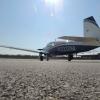In the spring of 2013, we discovered a case crack in our '78's IO-360A3B6D.
Over the years, we had work performed at Poplar Grove Airmotive so we discussed the situation with their staff. Options:
1. Fix the crack -- approx $12,000
2. Overhaul and fix the crack -- approx $24,000
3. Lyc reman (-A3B6) -- approx $32,000
4. Lyc new (-A3B6) -- approx $45,000
They strongly hinted at option "3" being the wisest, since the reman engine would likely come with a new case to support the roller tappet cam.
So...a bit over $32,000 for the engine, and about $10,000 for the install ( yikes! prop governor upgrade, oil cooler overhaul, exhaust system rebuild, hoses, mounts, baffles, vacuum pump, and so on). The work was performed at a well known Texas MSC.
For those interested, yes, the new engine runs $42,000 smoother.
